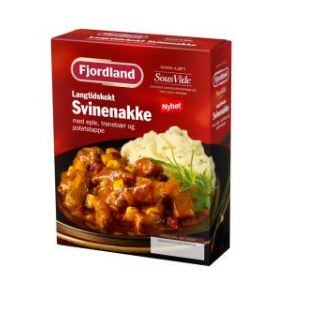Dubbing the process ‘low temperature, long time’ (LTLT), the researchers say it means consumers will be able to find gourmet-style foods in packaged formats.
The collaboration between scientists at the Norwegian Institute of Food, Fisheries and Aquaculture (Nofima) and the Culinary Institute of Norway (Gastanomisk Institutt) as well as food manufacturers saw five products commercially launched over the course of the project based on the results. The project started in 2013 and has now come to an end.
One Norwegian manufacturer Fjordland launched a pork neck with apple, cranberry and mashed potatoes to be cooked for 4.5 hours, which is the centre of their current marketing campaign.
Meanwhile fellow Norwegian brand

Nortura launched several products using pork belly, spare ribs and roasted pork knuckle. Wild game processor Vilteksperten carried out work on reindeer and elk.
One researcher involved in the project, Line Bach Christensen, told FoodNavigator: “Two different groups of enzymes are relevant in this context; the enzymes naturally occurring in the muscle, being responsible for continuously degradation and generation of muscle proteins in the live animal, and those enzymes – often of non-animal origin, such as fruit – you add together with a marinade prior to processing of the meat.
"Both types of enzymes are proteases that degrade proteins in the meat, and thereby tenderise the meat."
The Nofima researchers used actinidin, an enzyme derived from kiwifruit, but a variety of commercially available fruit enzymes in powder form could be used. Although not suitable for vegetables or fish, these fruit-based enzymes have been used in Japan to tenderise meat for years, said Bach Christensen.
“Heat treatments at low temperature for prolonged times makes it possible to add value to low price meat cuts. Adding enzymes to the meat in this process accelerates the tenderisation and makes it possible to add some taste and flavour to the meal.”

The researchers applied the heat treatment to meats that were both plain and marinated, and tested various lengths of time and temperatures ranging from 56°C to 80°C and from two hours up to three days, with certain combinations yielding product durability of up to six weeks.
Slow, low and safe
Lower cooking temperatures mean certain bacteria can survive, and so getting the right combination of time and temperature is important to ensuring the food is safe.
“Heat treatment below 60°C will, to an increasing degree, depend on the time it takes to achieve a sufficient reduction in bacteria count,” said lead researcher Jan Thomas Rosnes.
Although the project has now come to an end, the research in this area will continue.
"There are lots of opportunities to further increase the product quality for the consumer and to increase the sustainable exploitation of animals. There is a clear potential for increased earnings," said Nofima.
